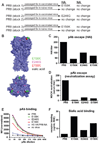Hemagglutinin receptor binding avidity drives influenza A virus antigenic drift
- PMID: 19900932
- PMCID: PMC2784927
- DOI: 10.1126/science.1178258
Hemagglutinin receptor binding avidity drives influenza A virus antigenic drift
Abstract
Rapid antigenic evolution in the influenza A virus hemagglutinin precludes effective vaccination with existing vaccines. To understand this phenomenon, we passaged virus in mice immunized with influenza vaccine. Neutralizing antibodies selected mutants with single-amino acid hemagglutinin substitutions that increased virus binding to cell surface glycan receptors. Passaging these high-avidity binding mutants in naïve mice, but not immune mice, selected for additional hemagglutinin substitutions that decreased cellular receptor binding avidity. Analyzing a panel of monoclonal antibody hemagglutinin escape mutants revealed a positive correlation between receptor binding avidity and escape from polyclonal antibodies. We propose that in response to variation in neutralizing antibody pressure between individuals, influenza A virus evolves by adjusting receptor binding avidity via amino acid substitutions throughout the hemagglutinin globular domain, many of which simultaneously alter antigenicity.
Figures



References
Publication types
MeSH terms
Substances
Grants and funding
LinkOut - more resources
Full Text Sources
Other Literature Sources

